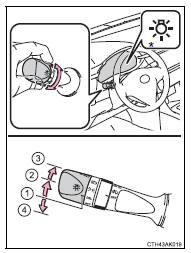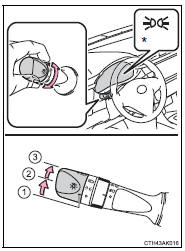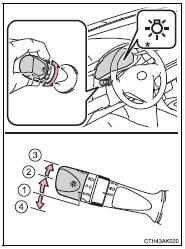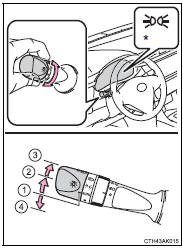Toyota Corolla (E170) 2014–2019 Owners Manual / Driving / Operating the lights and wipers / Headlight switch / Operating instructions
Toyota Corolla (E170): Operating instructions
Turning the end of the lever turns on the lights as follows: ► Type A
1  The daytime running lights turn
on.
The daytime running lights turn
on.
2  The side marker, parking, tail,
license plate, daytime running lights and instrument panel lights turn on.
The side marker, parking, tail,
license plate, daytime running lights and instrument panel lights turn on.
3  The headlights and all the lights
listed above (except daytime running lights) turn on.
The headlights and all the lights
listed above (except daytime running lights) turn on.
4  The daytime running lights turn
off.
The daytime running lights turn
off.
*: Vehicles with a multi-information display

► Type B
1  The daytime running lights turn
on
The daytime running lights turn
on
2  The side marker, parking, tail,
license plate, daytime running lights and instrument panel lights turn on.
The side marker, parking, tail,
license plate, daytime running lights and instrument panel lights turn on.
3  The headlights and all the
lights listed above (except daytime running lights) turn on.
The headlights and all the
lights listed above (except daytime running lights) turn on.
*: Vehicles with a multi-information display

► Type C
1  The headlights and all the lights
listed below turn on and off automatically.
The headlights and all the lights
listed below turn on and off automatically.
(Vehicles without a smart key system: When the engine switch is in the “ON” position) (Vehicles with a smart key system: When the engine switch is in IGNITION ON mode)
2  The side marker, parking, tail,
license plate, daytime running lights and instrument panel lights turn on.
The side marker, parking, tail,
license plate, daytime running lights and instrument panel lights turn on.
3  The headlights and all the lights
listed above (except daytime running lights) turn on.
The headlights and all the lights
listed above (except daytime running lights) turn on.
4  The daytime running lights turn
off.
The daytime running lights turn
off.
*: Vehicles with a multi-information display

► Type D
1  The headlights and all the lights
listed below turn on and off automatically.
The headlights and all the lights
listed below turn on and off automatically.
(Vehicles without a smart key system: When the engine switch is in the “ON” position) (Vehicles with a smart key system: When the engine switch is in IGNITION ON mode)
2  The side marker, parking, tail,
license plate, daytime running lights and instrument panel lights turn on.
The side marker, parking, tail,
license plate, daytime running lights and instrument panel lights turn on.
3  The headlights and all the lights
listed above (except daytime running lights) turn on.
The headlights and all the lights
listed above (except daytime running lights) turn on.
4  The daytime running lights turn
on.
The daytime running lights turn
on.
*: Vehicles with a multi-information display

Other materials:
Battery
Check the battery as follows.
■ Battery exterior
Make sure that the battery terminals are not corroded and that there are no
loose connections, cracks, or loose clamps.
1 Terminals
2 Hold-down clamp
■Before recharging
When recharging, the battery produces hydrogen gas which is ...
Inspection procedure
1 Inspect cruise control actuator assy
Inspect the cruise control actuator arm locking operation.
Turn the ignition switch to off.
Disconnect the cruise control actuator assy connector.
Connect the positive (+) lead from the battery to the
terminal 3 (l) of crui ...
Opening the trunk
■ Trunk opener
Pull the lever upward to release
the trunk lid.
■ Trunk release button (vehicles
with a smart key system)
While carrying the electronic
key, press the button on the
trunk lid.
When all the doors are unlocked
using one of the following methods,
the trunk can be opened
without the ...


